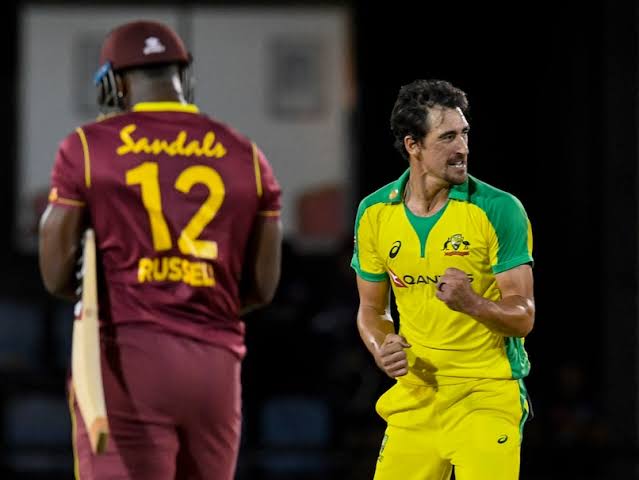Why the 'inconsequential' ODIs could hold great importance for Mitchell Starc, Nicholas Pooran and others
You’ll have to go all the way back to 2013 to find the last instance of Australia and West Indies locking horns with each other in a bilateral ODI series.

Or, in other words, the last time Australia and West Indies played a bilateral ODI series, Adam Voges was GOAT-ing it in international cricket, James Faulkner was yet to become The James Faulkner, Sunil Narine had a completely legal action and Tino Best was spearheading Windies’ limited-overs attack. Indeed, a lot has changed in 8 years.
One thing that hasn’t changed, however, is the fact of the Windies still being an average ODI side trying to figure the format out. Since the start of 2017, they’ve won 27 and lost 46 of the 80 ODIs they’ve played, and their ODI ranking of 8 is pretty reflective of their performances. Never in the past decade have they been able to translate T20 excellence into 50-over success, and so, despite brimming with confidence, they will head into the three-match ODI series against Australia knowing very well that the 20-over results will count for little, particularly against a side that has a clear understanding of the format.
There are valuable Super League points at stake for both sides, but it is hard to not imagine that the series will be completely about individuals. With both sides weakened - Australia, in particular, who will be without their six best ODI players - the eventual result might need to be taken with a pinch of salt, but there will, nevertheless, be an invaluable opportunity for individuals from both sides - some of whom are at a critical stage in their international careers - to emerge out of the series as real winners.
Mitchell Starc’s opportunity to arrest his ODI slump
Mitchell Starc might very well arguably be the greatest ODI bowler of the past decade, but since his exploits in the 2019 World Cup, the talisman has been a liability for Australia in the 50-over format. Since post the 2019 World Cup, Starc has averaged an unremarkable 54.25 with the ball in ODIs and has leaked runs at an ER of 6.28, while also going wicketless in 45% of the matches (5/11). His form hit its nether in the three-match ODI series against India towards the back end of last year, where he averaged 147.00 and conceded 8.16 runs per over, almost single-handedly undoing the batsmen’s efforts of posting daunting 350-plus totals.
That Starc now does not swing the ball in white-ball cricket as proficiently as he once used to is a fact well known, but the primary contributor to his decline in 50-over cricket - or slump, if you don’t want to be too harsh - has been his abject loss of control. This pitch map from the 2nd ODI against India in Sydney last year, where he returned figures of 0/82 off 9 overs, serves as a perfect depiction of Starc’s struggles.
Mitchell Starc appears to be struggling for rhythm and consistency today. Any delivery that has offered width or been too full/short of a length has been punished.#AUSvIND pic.twitter.com/alF07fFNk1
— The CricViz Analyst (@cricvizanalyst) November 29, 2020
Starc did begin the T20I series versus the Windies in Sydney mode, but there were encouraging signs in the 3rd and 4th T20Is. He bowled an incredibly parsimonious spell in the third - 1/15 off 4 overs - and piggybacked off that confidence to deliver a match-winning final over in the fourth, where he strangled The Andre Russell. Regardless of how poorly Russell batted in that over, an out-of-form, down-on-confidence Starc would never have defended 11 off the final over.
And so here’s an opportunity for him to further build on that confidence and not just arrest this wretched ODI slump, but also raise his stocks ahead of the World T20. No batsman in the world, in any format, fancies coming up against a tails-up Mitchell Starc, and through a strong showing across these three ODIs, the left-armer could threaten to peak in time for the World Cup. Historically the Windies have been Starc’s favorite opponents - 21 wickets in 7 ODIs @ 12.76 - and the New South Welshman would love for history to repeat itself come the 20th.
Shai Hope’s turn to prove that he is world class
Since Jan 1,2018, only Virat Kohli and Rohit Sharma have scored more ODI runs than Shai Hope. Among the two, only Kohli has done so at a higher average. Yet when you go around asking who the best openers in the world are, seldom do people take the name of Hope. Partly because he is a 2021 batter batting with a 2001 strike rate - 76.92 in the aforementioned timeframe - and partly because the who and wheres of his runs have been oddly specific.
37.5% of Hope’s ODI runs have come against Sri Lanka and Bangladesh, and 34.84% of 3,547 have been scored in the sub-continent. Batsmen, in general, have favorite opponents and favorite regions, but this oddly specific dominance of Hope is something that’s been never heard of.
Ironically, however, this specific dominance of Hope has been used as a stick to beat him, by some. Outside of Bangladesh, Sri Lanka and Afghanistan, Hope’s average drops to 40, with only 13 of his 29 fifty-plus scores coming against the rest of the world. Remove India, too, and this number further plummets to 34.45.
It is, of course, silly to invalidate Hope’s achievements by using this argument, for every batsman’s record would look considerably worse if you remove his favorite opponent(s), but criticism, sometimes, isn’t logical. After all, it is not Hope’s fault that he’s played a total of just 10 games against Australia, New Zealand, South Africa and Pakistan.
Nevertheless, he could put all those criticisms to bed, and establish himself as a genuinely world-class opener, by shining across these three ODIs. Australia might be missing a lot of key batsmen, but it is worth noting that, outside of Pat Cummins, what they have at their disposal is pretty much their full-strength bowling line-up.
Mitchell Marsh’s chance to snatch Stoinis’ spot
Not in his wildest dreams would Mitchell Marsh have dreamt of having the kind of T20I series he had - 219 runs and 8 wickets - but such is the nature of sport. Marsh boarded the flight to the Caribbean Islands not knowing if he’d be in the World T20 squad but, as things stand, on current form, he arguably is the first pick. So with a WT20 spot now in the pocket, it’s time for Marsh to get greedy and shift his focus towards sealing a berth in the ODI team.
Now, where Marsh will bat in this (weakened) Australian side remains to be seen. But where he will bat in a full-strength ODI side will be at No.5, with all of Smith (3), Labuschagne (4), Carey (6) and Maxwell (7) being automatic picks.
Marsh, in a full strength side, would be competing directly with Marcus Stoinis (perhaps also Cameron Green, but not immediately) due to his ability to bowl useful overs of seam, and he could steer well clear of the Melbourne Stars man with a dominant showing come the ODIs.
Stoinis might be a senior member in the Australian set-up, but his stocks in 50-over cricket have been plummeting for some time now. Since 2019, the right-hander has averaged a mere 21.38 with the bat, while picking just 15 wickets at an average of 48.33.
For all the flack he gets for being a failed Test cricketer, Marsh boasts an excellent ODI record - 34.36 average and 90 SR with the bat; 49 wickets at 36.79 with the ball. These three games might be of little consequence for the visitors, but they could potentially be career-defining for the once-most-hated-cricketer-in-Australia.
Pooran’s need to discover his fluency
Much like Mitchell Starc, Nicholas Pooran is a man desperately trying to rediscover his best touch, and much like his Australian counterpart, Pooran showed glimpses of finding form in the T20Is. In the third T20I, he played a mature hand to seal a series win for his side, while in the fifth, he cut loose and unleashed a hat-trick of sixes before his innings was cut short before it could reach its climax.
Unlike in T20I cricket, Pooran has not struggled in ODIs. Since after the 2019 World Cup, he has averaged 51.25 (while also striking at 111) and has never found himself in a rut like he has in the shortest format. He has only played three ODIs post the pandemic, and in one of those he took the Windies over the line in a nervy chase, smashing 9 runs off Nuwan Pradeep’s final over.
Still, fluency has evaded Pooran in all forms of cricket this year, and it is something he would be hoping to rediscover in these three ODIs. With the five-T20I series against Pakistan slated to commence at the end of this month, Pooran would go a long way by reawakening the beast inside him in the ODIs against the Aussies. Pooran is, really, the only out-of-form batter in this Windies line-up, and him rediscovering his touch would make the West Indies’ batting all but invincible.

Comments
Sign up or log in to your account to leave comments and reactions
0 Comments